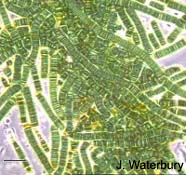The Earliest Life
 Way back then, life forms weren’t based on DNA (stands
for deoxyribonucleic acid, the stuff that makes up our chromosomes
and carries genetic information from parent to child), the way life
as we know it is. The earliest living things were simple organisms,
far less complex than the virus that gave you a cold last winter.
In fact, by today’s standards, you would hardly call these substances
“life” at all. But they did share one important trait in today’s life
forms; they had the ability to reproduce. Simple as they were,
they eventually evolved into more complex organisms.
One of the first complex organisms to appear on the scene was
cyanobacteria (blue-green algae),
which have the ability to live in anaerobic (no oxygen) environments.
Just like a tree, blue-green algae take in carbon dioxide and releases oxygen.
Once these algae reproduced and spread around the world,
it was just a matter of time (a long time)
before Earth’s atmosphere contained its own free oxygen.
Oxygen was the key that eventually allowed more complex animals, like people,
to survive on Earth.
FROM CELLS TO PEOPLE All of us can trace our roots back to these ancient,
single-celled ancestors.
That’s why our blood is so salty – now that we don’t live in the ocean,
we literally carry it around inside of us, in our veins.
Way back then, life forms weren’t based on DNA (stands
for deoxyribonucleic acid, the stuff that makes up our chromosomes
and carries genetic information from parent to child), the way life
as we know it is. The earliest living things were simple organisms,
far less complex than the virus that gave you a cold last winter.
In fact, by today’s standards, you would hardly call these substances
“life” at all. But they did share one important trait in today’s life
forms; they had the ability to reproduce. Simple as they were,
they eventually evolved into more complex organisms.
One of the first complex organisms to appear on the scene was
cyanobacteria (blue-green algae),
which have the ability to live in anaerobic (no oxygen) environments.
Just like a tree, blue-green algae take in carbon dioxide and releases oxygen.
Once these algae reproduced and spread around the world,
it was just a matter of time (a long time)
before Earth’s atmosphere contained its own free oxygen.
Oxygen was the key that eventually allowed more complex animals, like people,
to survive on Earth.
FROM CELLS TO PEOPLE All of us can trace our roots back to these ancient,
single-celled ancestors.
That’s why our blood is so salty – now that we don’t live in the ocean,
we literally carry it around inside of us, in our veins.



 Way back then, life forms weren’t based on DNA (stands
for deoxyribonucleic acid, the stuff that makes up our chromosomes
and carries genetic information from parent to child), the way life
as we know it is. The earliest living things were simple organisms,
far less complex than the virus that gave you a cold last winter.
In fact, by today’s standards, you would hardly call these substances
“life” at all. But they did share one important trait in today’s life
forms; they had the ability to reproduce. Simple as they were,
they eventually evolved into more complex organisms.
One of the first complex organisms to appear on the scene was
cyanobacteria (blue-green algae),
which have the ability to live in anaerobic (no oxygen) environments.
Just like a tree, blue-green algae take in carbon dioxide and releases oxygen.
Once these algae reproduced and spread around the world,
it was just a matter of time (a long time)
before Earth’s atmosphere contained its own free oxygen.
Oxygen was the key that eventually allowed more complex animals, like people,
to survive on Earth.
FROM CELLS TO PEOPLE All of us can trace our roots back to these ancient,
single-celled ancestors.
That’s why our blood is so salty – now that we don’t live in the ocean,
we literally carry it around inside of us, in our veins.
Way back then, life forms weren’t based on DNA (stands
for deoxyribonucleic acid, the stuff that makes up our chromosomes
and carries genetic information from parent to child), the way life
as we know it is. The earliest living things were simple organisms,
far less complex than the virus that gave you a cold last winter.
In fact, by today’s standards, you would hardly call these substances
“life” at all. But they did share one important trait in today’s life
forms; they had the ability to reproduce. Simple as they were,
they eventually evolved into more complex organisms.
One of the first complex organisms to appear on the scene was
cyanobacteria (blue-green algae),
which have the ability to live in anaerobic (no oxygen) environments.
Just like a tree, blue-green algae take in carbon dioxide and releases oxygen.
Once these algae reproduced and spread around the world,
it was just a matter of time (a long time)
before Earth’s atmosphere contained its own free oxygen.
Oxygen was the key that eventually allowed more complex animals, like people,
to survive on Earth.
FROM CELLS TO PEOPLE All of us can trace our roots back to these ancient,
single-celled ancestors.
That’s why our blood is so salty – now that we don’t live in the ocean,
we literally carry it around inside of us, in our veins.


